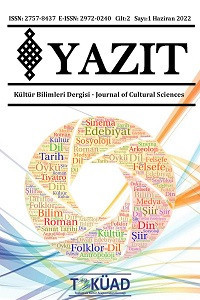-(I)ntI Eki, Ekin Kök ve Gövdelerle Oluşturduğu Fonosemantik Durum
{-(I)ntI} eki, kimi kök ve gövdelerde bir bütün gibi görünmekte, kimi kök ve gövdelerde de ekin iki ayrı parçadan oluştuğu anlaşılmaktadır. Özellikle n sesi ile biten kelimelerin bir bölümü bugün kullanılmamaktadır. Bazıları da eski metinlerde bulunmamaktadır. Bir de bu n'li biçimlerde dikkati çeken unsur, kök ya da gövdelerdeki ses dizgeleri ve bunların kattığı anlamlardır. Elbette ek, köke göre bir anlam katar. Asıl önemli taraf bu kelimelerdeki ses dizilişlerinin birbirinden çok farklı şekiller sergilemesidir. Bu dizilişlerle ekler arasında n'li gövdelerin oluşumu arasında doğrudan bağlantı vardır. Ses dizgeleri anlamı etkiler. Bu da fonosemantik dediğimiz uyumu oluşturur. Fonosemantik kavramı ses ile anlam arasındaki ilişkiyi ifade eder. Bulgular, kelimelerdeki seslerin tesadüfi olarak seçilmediğini, bunların belli kurallar çerçevesinde yan yana gelerek bir bütün oluşturduğunu göstermektedir. Ses ile biçim arasında bir uyum olduğu gibi, ses ile anlam arasında da bir uyum vardır. Uyumu ve ahengi sağlayan sonuçta anlamı oluşturan seslerin belli kurallar çerçevesinde dizilişidir. Asıl anlamı oluşturan elbette eklerden ziyade köklerdeki sesler ve onların dizilişleridir. Ses yoksa, sesler belli kural ve mantık dokusu içinde yan yana gelmiyorsa anlam da yoktur. Anlam sesler sayesinde var olur. Burada {-(I)ntI} eki ile biten kelimeler biçimsel özelliklerine göre beş grup içinde değerlendirilmiştir. Ses ve anlam bağlantısında ünlü ve ünsüzlerin ayrımı yapılsa ünsüzlerin yapıyı oluşturmada ünlülere göre biraz daha ağır bastığı {-(I)ntI} ekinin geldiği kök ve gövdelere göre söylenebilir.
Anahtar Kelimeler:
-(I)ntI eki, ses dizgeleri, kök, gövde, fonosemantik durum
-(I)ntI Suffix, the Phonosemantic Status Created by the Root and Stem
The {-(I)ntI} suffix appears to be a whole in some roots and stems, and it is understood that the suffix consists of two separate parts in some roots and stems. Especially some of the words ending with the n sound are not used today. Some are not found in ancient texts. Also, what draws attention in these n forms is the sound strings in the roots or stems and the meanings they add. Of course, the suffix adds meaning relative to the root. The most important thing is that the sound sequences in these words exhibit very different shapes from each other. There is a direct connection between these sequences and the formation of n bodies between suffixes. Sound strings affect meaning. This creates the harmony we call phonosemantic. The concept of phonosemantic expresses the relationship between sound and meaning. The findings show that the sounds in the words are not chosen randomly, and that they form a whole by coming together within the framework of certain rules. Just as there is a harmony between sound and form, there is also a harmony between sound and meaning. It is the arrangement of the sounds within the framework of certain rules, which ultimately creates the meaning that provides harmony and harmony. Of course, the main meaning is the sounds in the roots and their arrangement rather than the suffixes. If there is no sound, if the sounds do not come together within a certain rule and logic, there is no meaning. Meaning exists through sounds. Here, words ending with the suffix {-(I)ntI} are evaluated in five groups according to their formal characteristics. If vowels and consonants are distinguished in the connection of sound and meaning, it can be said that consonants outweigh the vowels in forming the structure, according to the roots and stems from which the suffix {-(I)ntI} comes.
Keywords:
-(I)ntI suffix, sound strings, root, stem, phonosemantic situation,
___
- Banguoğlu, Tahsin (1998). Türkçenin Grameri. Ankara: TDK Yayınları.
- Bilgegil, Kaya (1984). Türkçe Dilbilgisi. İstanbul: Dergâh Yayınları.
- Bozkurt, Fuat (2000). Türkiye Türkçesi. Ankara: Hatiboğlu Yayınları.
- Coşkun, Volkan (2016). Türkçenin Ses Bilgisi. İstanbul: Bilge Kültür Sanat.
- Doğan, Levent vd. (2006). Üniversiteler İçin Türk Dili Yazılı ve Sözlü Anlatım. Ankara: Nobel Yayınları.
- Ediskun, Haydar (2007). Türk Dilbilgisi. İstanbul: Remzi Kitabevi.
- Eker, Süer (2003). Çağdaş Türk Dili. Ankara: Grafiker Yayınları.
- Ergin, Muharrem (1998). Türk Dil Bilgisi. İstanbul: Bayrak Yayınları.
- Gencan, Tahir Nejat (2001). Dilbilgisi. Ankara: Ayraç Yayınevi.
- Göker, Osman (2001). Uygulamalı Türkçe Bilgileri I-II-III. Ankara: MEB Yayınları.
- Gülensoy, Tuncer (2007). Türkiye Türkçesindeki Türkçe Sözcüklerin Köken Bilgisi Sözlüğü. Ankara: TDK Yayınları.
- Hatiboğlu, Vecihe (1981). Türkçenin Ekleri. Ankara: TDK Yayınları.
- Hengirmen, Mehmet (2005). Türkçe Dilbilgisi. Ankara: Engin Yayınevi.
- İslam Ansiklopedisi (1997). Türk Dili Maddesi. C.12/2. Eskişehir: MEB Yayınları.
- Karasoy, Yakup vd. (2007). Uygulamalı Türk Dili ve Kompozisyon Bilgileri. Ankara: Akçağ Yayınları.
- Korkmaz, Zeynep (2003). Türkiye Türkçesi Grameri, (Şekil Bilgisi). Ankara: TDK Yayınları.
- Korkmaz, Zeynep vd. (1992). Türk Dili ve Kompozisyon Bilgileri. Ankara: YÖK Yayınları.
- Özkırımlı, Atilla (2001). Türk Dili, Dil ve Anlatım. İstanbul: İstanbul Bilgi Üniversitesi Yayınları.
- Paçacıoğlu, Burhan (2016). VIII.-XVI. Yüzyıllar Arasında Türkçenin Sözcük Dağarcığı. İstanbul: Kesit Yayınları.
- Yakıcı, Ali vd. (2005). Üniversiteler İçin Türk Dili ve Kompozisyon Bilgileri. Ankara: Bilge Yayınları.
- Yaman, Ertuğrul ve Köstekçi, Mehmet (2003). Türk Dili ve Kompozisyon. Ankara: Gazi Kitabevi.
- Yavuz, Kemal vd. (1998). Üniversite Türk Dili ve Kompozisyon Dersleri. İstanbul: Bayrak Yayınları.
- ISSN: 2757-8437
- Başlangıç: 2021
- Yayıncı: TOKÜAD-Toplum ve Kültür Araştırmaları Derneği
Sayıdaki Diğer Makaleler
Ahmet Kekeç’in Yağmurdan Sonra Romanı Örneğinde 1980 Sonrası Türk Romanında Özeleştirel İslami Roman
Pınar Kür'ün Asılacak Kadın Romanında Kadınlar ve Aşk
Geleneksel Kültürün Yapılaşmış Çevreye Etkisi: Çerkes Kültürü Örneği
Kazak Folklorunda Hz. Nuh ve Kazıkurt Dağı Hakkında Efsaneler
Türk Kültüründe Domuz ve Beslenmeye Etki Eden Faktörler
Özkan Mert'in Poetikasında Nehir Şiir Kavramı ve Aşk Teması
Dağ Kültü ve Divan Şiirinde Mitolojik Dağlar
Mavi Anadolucu Cevat Şakir’in Ötelerin Çocukları Romanında Karşıtlıklar Üzerine
-(I)ntI Eki, Ekin Kök ve Gövdelerle Oluşturduğu Fonosemantik Durum
